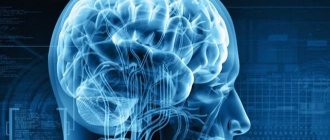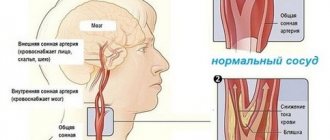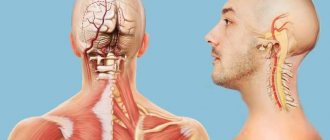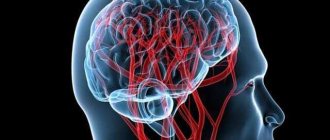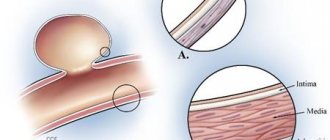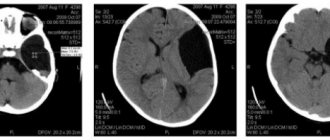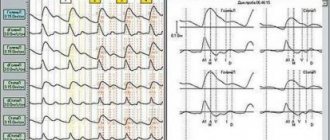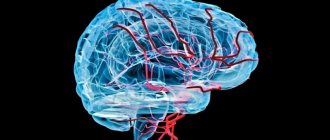Cholesterol plaques in the vessels of the brain are the result of the influence of a number of factors on the human body, including genetics, poor diet, sedentary lifestyle, etc. Such formations are considered extremely dangerous, since their separation from the wall of the vessel can lead to blocking its lumen and the development of ischemic stroke. Cerebral atherosclerosis is a common disorder in people over 40–45 years of age.
The appearance of plaques that narrow the lumens of blood vessels is due to hormonal changes that are observed in the body at this age. In addition, young people suffering from obesity are at particular risk of developing this pathological condition. According to statistics, cerebral atherosclerosis is approximately 2–3 times more likely to be detected in middle-aged men.
Etiology of cholesterol plaques in brain vessels
The exact reasons for the development of this pathological condition still remain a mystery. A long-term study of patients with a similar problem made it possible to identify factors that may contribute to the appearance of cerebral atherosclerosis. A special risk group includes people who tend to systematically eat poorly. This leads not only to the accumulation of fatty deposits, but also to increased cholesterol levels.
This substance is the main building material for the formation of plaques on the walls of blood vessels. Factors that help speed up this process include:
- inactive lifestyle;
- bad habits;
- viral infections;
- high blood pressure;
- metabolic disorders of various etiologies;
- endocrine diseases.
Poor ecology plays an important role in the formation of cholesterol plaques in the blood vessels of the human brain. Relatively recently, it was noticed that people who work in hazardous industries, as well as residents of large cities, are much more likely to encounter this problem than those who are engaged in agriculture and live in the countryside all year round.
Considerable attention is currently being paid to the genetic component. Many people suffering from cerebral atherosclerosis have relatives with a similar problem.
Causes of atherosclerosis
There are various theories to explain the formation of plaques. According to one of them, the trigger is a slowdown in blood flow due to a physical obstruction, for example, a branching artery or arteriole. Lipids enter the lining of the vessel from its lumen - they penetrate along with the blood plasma. The process is accelerated by hypertension and oxygen starvation (hypoxia).
First, fibrosis occurs - the replacement of normal tissue in the artery wall with connective tissue. During this period, the plaque is still soft. Parts of the seal in the first stages can be torn off by the blood flow, migrate through the vessels, and settle in the narrowest places. Inflammation promotes further accumulation of cholesterol and calcium.
How plaque formation affects the blood supply to organs:
- As a result of the inflammatory process, the inner wall of the vessel thickens.
- Accumulations of cholesterol, calcium, and proliferation of connective tissue narrow blood flow.
- Tissues and organs are not sufficiently supplied with oxygen and essential nutrients.
- When atherosclerotic plaques are destroyed, blood clots form, which can completely block the lumen of small vessels.
There are other descriptions of the mechanism of development of atherosclerosis and the formation of plaques in blood vessels. For example, the hypothesis of the influence of “bad” cholesterol, which transports lipids from the liver to cells throughout the body. This fat can accumulate on the inner walls of the arteries. The inflammatory process develops, leukocytes migrate and further absorption of lipids occurs. A “fatty stripe” is formed in the vascular wall—the “foundation” of an atherosclerotic plaque.
All the conditions that influence the occurrence of vascular pathology are still unknown. Under the influence of various factors, which often act together, metabolism is disrupted. It has been established that there is a genetic predisposition to the development of an inflammatory process in the vascular wall. Heart attacks and strokes often affect close relatives.
Reasons why plaques form in blood vessels:
- a combination of high levels of “bad” cholesterol and obesity;
- lack of physical activity (physical inactivity);
- high blood pressure;
- unfavorable heredity;
- excess animal fats in food;
- lipid metabolism disorders;
- smoking, including passive smoking;
- alcohol abuse;
- diabetes;
- intoxication.
According to one theory, the inner wall of the vessel becomes inflamed due to exposure to toxins from bacteria, viruses and the immune response. Atherosclerosis often develops against the background of other diseases, such as hyperthyroidism, gout, and autoimmune processes.
Main manifestations of the disease
In this pathological condition, the entire brain suffers from cholesterol plaques. As such formations increase, they gradually narrow the lumen of the vessels, which helps slow blood flow.
In addition, they tend to spread throughout the vascular bed. At the attachment points of such formations, the vessel wall becomes deformed and thinned, which significantly increases the risk of rupture when blood pressure rises.
Disruption of normal blood circulation in the vessels of the brain leads to the fact that the cells do not receive the required amount of oxygen. Cholesterol plaques that completely or partially block the blood flow can affect large areas of this vital organ.
With atherosclerosis of this type, symptomatic manifestations increase slowly. Depending on the degree of circulatory impairment in the brain, people suffering from this pathological condition may complain of short-term or prolonged headaches.
Usually, unpleasant sensations do not have a clear localization. The intensity of pain can vary from mild to very severe. Among other things, people suffering from atherosclerosis often complain of dizziness and tinnitus. Similar symptoms often appear when lifting heavy objects, changing weather conditions, being in extreme heat, or making sudden movements.
In some cases, sleep disturbance is observed against the background of the development of this pathological condition. You may have frequent nightmares. With cerebral atherosclerosis, daytime drowsiness and nighttime insomnia may occur. In most cases, against the background of this pathological condition, there is a significant decrease in short-term and long-term memory, as well as rapid fatigue. Often people with cerebral atherosclerosis complain of a significant decrease in performance. In the future, a person may become overly irritable, suspicious, meticulous, etc.
In especially severe cases, when the cerebellum is damaged, against the background of increasing hypoxia, impaired coordination of movements and slowness may appear. In addition, in some cases, people suffering from this pathological condition experience the appearance of unclear speech.
Dandelion roots
You can use dandelion roots even with deep atherosclerosis. The essence of treatment is to remove excess cholesterol and toxins from the affected body. This method is very simple. You need to take dry dandelion roots and grind them into powder. Take 5 g before going to bed. Therapy lasts 6 months.
To clean blood vessels from cholesterol, you can use jaundice kvass. You need to grind 50 g of raw material and place it in a gauze bag. Attach weights to it and add 3 liters of boiling water. All that remains is to place 250 g of sugar and 5 g of sour cream. Place in a dark room for 2 weeks. The daily dosage is 360 ml, drink in 3 doses.
Possible complications
The gradual narrowing of the lumens of the blood vessels that supply brain tissue, in the absence of targeted treatment, can cause the development of severe disorders. The risk of developing hemorrhagic and ischemic stroke increases several times. These conditions can pose a danger to human life, and in addition are fraught with the development of paralysis, paresis, cognitive and mental disorders.
Ischemic stroke usually develops when atherosclerotic plaques in the blood vessels of the brain completely block the lumen, or such a formation breaks off and blocks blood flow. This leads to the fact that oxygen ceases to flow into a certain part of the brain, which first causes hypoxia and then tissue death.
Hemorrhagic stroke in cerebral atherosclerosis is observed in people who have arterial hypertension. In this case, the vessel, which is narrowed in a particular place due to the presence of a cholesterol plaque, cannot withstand the increased load and therefore ruptures.
Among other things, cerebral atherosclerosis significantly increases the risk of developing a transient ischemic attack. In addition, a person with multiple cholesterol plaques in the vessels located in the brain is likely to develop severe dyscirculatory encephalopathy.
Symptoms of cervical vasoconstriction
The most dangerous are cholesterol deposits in the blood vessels of the brain. They are the least treatable and most endanger a person’s life.
If plaque growths are significant, the patient may experience:
- Severe migraines;
- Frequent dizziness;
- Insomnia;
- Increased anxiety;
- Psychical deviations;
- General mental instability.
In the advanced course of the disease, mental instability manifests itself in insensitivity to new information, poor memory and the inability to self-care. At this stage of development, the disease is virtually untreatable.
The main symptom of this localization is intermittent claudication. This is a condition in which, while walking, a person is forced to stop, shifting from foot to foot, in order to relieve pain.
With the development of atherosclerosis of the lower extremities, the color of the skin on the legs, especially on the feet, changes. It takes on a bluish tint. Feet are constantly cold, even when it’s warm a person always puts on warm socks.
The most severe symptoms are signs of an advanced stage - necrosis of individual tissues of the legs, in which there is no blood supply and the tissues die. Trophic ulcers develop, and gangrene of the feet may form.
The vessels of the cervical spine provide a complete supply of oxygen and nutrients to the vessels of the entire head. Therefore, the formation of plaques in them is very dangerous.
The symptoms are very striking, since with this localization the entire brain suffers:
- The initial sign is a feeling of discomfort and stiffness in the cervical spine;
- Then frequent dizziness begins to develop;
- All this provokes a further loss of strength and a general deterioration in well-being;
- Then memory deteriorates.
The insidiousness of the disease is that a person gradually gets used to pain in the neck, ceasing to pay attention to it. This further increases the risks, since, over time, the likelihood of thrombosis and complete blockage of blood vessels develops. Thus, affecting an important vessel, a blood clot often provokes death.
When you first contact a therapist with the symptoms described above, first of all, the doctor will prescribe a test that will reveal the cholesterol content and a detailed study of all its fractions. This testing is called a lipid profile.
If the results of this diagnostic do not clearly exceed the normalized values, then this can be limited. But if the indicators are greatly overestimated, then an experienced specialist will understand that, most likely, the disease is already in advanced stages, when cholesterol plaques appear.
Research is possible only when they are already clearly visible. This means that the situation has started.
Therefore, for the purpose of preventive examination, it is necessary to take blood biochemistry annually, or perform a basic test to detect cholesterol levels using a portable analyzer.
In modern life, in order to monitor your health, you do not need to spend a lot of time, effort and money. And even if preventive studies are paid, they are quite accessible to the average class.
If deviations from the norm are detected, the therapist may then prescribe additional examinations for:
- Surgeon;
- Neurologist;
- Cardiologist;
- Nephrologist;
- Nutritionist.
The following tests serve as laboratory and instrumental diagnostics:
- CBC and blood biochemistry;
- OAM;
- CT;
- MRI;
- ECG;
- Vascular ultrasound.
The last type of analysis is the most promising in the study of atherosclerotic plaques of the cervical vessels. But, as already mentioned, their exact identification is determined when the lumen is either very narrowed or completely closed.
Prevention of the appearance of cholesterol plaques can be:
- Primary. Its essence is to prevent the occurrence of atherosclerosis. To do this you need:
- Eat right, this point is the first and most important, because the formation of plaques occurs from the accumulation of low-density lipoproteins; this type of cholesterol has increased values due to the high content in the diet of foods with a high percentage of animal fats;
- Eliminate bad habits, such as drinking alcohol and smoking, since alcohol vapor, nicotine and tar destroy the walls of blood vessels, thinning them and allowing blood clots to form in them;
- Move more, walking in the fresh air and taking at least 10,000 steps a day;
- Engage in a feasible sport, as this will help establish a regime, discipline and give strength to maintain a diet and a healthy lifestyle;
- Try to exclude nervous situations, as this has a detrimental effect on blood pressure, causing it to jump and provoking the risk of blood clots;
- From time to time, use herbal medicine as prescribed by a doctor, which will help strengthen the nervous system and cleanse blood vessels.
- Secondary. This type of prevention is based on the fact that even if atherosclerosis occurs, its development can be inhibited through therapy and further prevention. Methods of secondary prevention include all the previous ones, and also add:
- Appropriate treatment with medications prescribed by the attending physician;
- Treatment of concomitant diseases;
- Regular monitoring of blood pressure;
- Timely testing for cholesterol levels.
Diagnosis of cholesterol plaques in brain vessels
With this pathological condition, you should not self-medicate. If there are characteristic signs of cholesterol plaques in the vessels of the brain, you need to contact a specialist to conduct a series of studies. First of all, a lipid profile is performed. This study allows you to determine the risk of atherosclerotic plaque formation.
Often a necessary measure is to conduct color duplex scanning. This is a special type of ultrasound. Typically, this test can detect obstruction of blood flow in the lower extremities, aorta, and blood vessels leading to the brain. In addition, this type of ultrasound can detect cholesterol deposits in the blood vessels that supply the retina.
A triplex scan may be recommended. This is another type of ultrasound that allows you to examine the vessels that are located inside the skull. To clarify the location of cholesterol plaques on the walls, angiography is often performed.
Among other things, doctors may prescribe a number of additional blood tests. After a comprehensive diagnosis, a specialist can determine the best treatment option, taking into account all the existing features.
Symptoms
Symptoms that indicate the presence of plaques in the vessels of the brain develop gradually and depend on the stage of the disease.
- A person gets tired quickly, often gets irritated, performance decreases, and chronic fatigue is observed;
- Memory weakens, forgetfulness develops;
- Frequent headaches begin, which vary in intensity, dizziness;
- The patient complains of a burning sensation in the back of the head, numbness or tingling of the fingers of the lower and upper extremities, hearing impairment;
- Negative changes in the emotional background occur: a depressive state develops, fear or inexplicable euphoria, tearfulness, a feeling of lethargy or excessive excitability;
- The patient has speech disorders, he constantly wants to sleep during the daytime, and in the morning he has difficulty waking up, often suffers from insomnia and nightmares;
- When the plaques increase in size, disturbances in the functioning of the vestibular apparatus occur, trembling in the arms and legs, uncertainty in gait, and soreness when eating.
Improvement also occurs after walking, because they contribute to an intensive supply of oxygen to the brain. At the initial stage of the disease, few patients pay attention to the listed symptoms and do not visit a doctor. And only when the symptoms worsen do patients sound the alarm.
Methods for eliminating the disease
How to get rid of plaques in the vessels of the brain must be decided by the attending physician. In order to eliminate this problem, it is necessary to change your diet and lifestyle. And be sure to take the prescribed medications. If this is not enough, surgery may be required. This method of influence is resorted to only in extreme cases.
So, cleaning blood vessels from cholesterol plaques begins with lifestyle changes. First of all, it is necessary to increase physical activity, regularly take long walks in the fresh air. Among other things, you should try to avoid stressful situations. It is very important to give up smoking and alcohol. It is advisable to start doing race walking, swimming, dancing, aerobics and running.
To clean blood vessels from cholesterol plaques without complications, it is necessary to normalize blood pressure and carefully monitor the level of cholesterol in the blood. It is definitely recommended to radically change your approach to nutrition. You need to include in your diet:
- seafood;
- milk and its derivatives with a low fat content;
- porridge;
- eggs;
- vegetables and fruits;
- freshly squeezed fruit drinks and juices;
- tea without sugar;
- compotes.
When the question arises of how to cleanse blood vessels from atherosclerotic plaques, the drugs necessary to stimulate this process must be selected. This pathological condition must be treated with a combination of remedies. Necessary medications include:
- statins;
- fibrates;
- nicotinic acid derivatives;
- antiplatelet agents;
- vitamins;
- antihypertensive drugs;
- vasodilators.
People often have to take medications for the rest of their lives. Since it is not always possible to clean the blood vessels of the brain using conservative methods, the attending physician may insist on surgical intervention. To cleanse the beds of cholesterol plaques, endoscopic exposure or endarterectomy is usually used.
Treatment methods
Treatment can be carried out with the help of medications, under the strict supervision of a specialist.
Non-drug therapy
Methods of non-drug therapy of atherosclerosis are reduced to the following principles:
- low cholesterol diet - it is necessary to limit the intake of animal fats as much as possible,
- eat more foods useful for atherosclerosis - cabbage, cottage cheese, potatoes,
- treat obesity, if it exists,
- completely eradicate bad habits,
- Constantly monitor blood pressure and, if necessary, treat hypertension,
- observe the work and rest schedule.
Drug therapy
Treatment of cholesterol clots in the vessels of the brain can be carried out using medications, under the strict supervision of a specialist. Doctors usually prescribe the following medications:
- statins – used in the treatment of hypercholesterolemia. They help normalize the level of lipoproteins in the body, reduce the size of cholesterol clots, preventing them from growing. Treatment with these drugs usually takes a long time. Tests to assess the effectiveness of treatment are done only 2-3 months after the start of therapy,
- fibrates – help reduce cholesterol and triglycerides in the body. Course treatment. Results can be seen after 4-8 weeks of therapy.
- nicotinic acid and its derivatives are auxiliary agents sometimes used during the treatment of atherosclerosis of the cerebral arteries,
- Ezitemib and Orlistat are medications used to treat obesity. They stop the absorption of lipoproteins and fatty acids by the walls of the small intestine, which leads to a decrease in the concentration of cholesterol in the body. Relatively recently, these drugs began to be used during the treatment of fatty clots in the vessels supplying the brain,
- bile acid sequestrants - help bind fatty acids in the duodenum and prevent them from entering the blood,
- antihypertensive drugs – used to lower blood pressure in hypertension,
- antiplatelet agents – drugs prevent the formation of blood clots by thinning the blood. Therapy should be long-term and regular,
- vitamins – for general strengthening of the body.
Important! The best therapeutic effect is achieved with complex treatment.
Surgical methods of treatment
While there is still a risk of complete blocking of blood flow in the vital vessels that supply the brain, cholesterol plaques are treated with surgical methods of treatment:
- endarterectomy is a method of external removal of a fat clot through a skin incision and removal of a large vessel that supplies the brain with blood, which contains oxygen and useful substances,
- endoscopic removal of an atherosclerotic clot using a small incision and an endoscope.
Treatment with folk remedies
You can cleanse the blood vessels of the brain if you drink strong tea with milk every day
Cleaning blood vessels from cholesterol plaques using folk remedies is quite successful. Brain vessels can be cleansed using:
- natural vitamins - every day you need to eat kiwi, grapefruit, pepper, lemons - foods rich in vitamin C, which helps dissolve atherosclerotic formations in the cerebral arteries. This method of cleansing is as safe as possible for health,
- Rowan decoction - you need to drink tea from the fruits of ordinary rowan, half a glass 3-4 times a day. This gentle cleaning regimen is based on the action of antioxidants and vitamins present in the rowan fruit,
- beets - use beet kvass. To prepare, you need to grate one kilogram of sugar beets, place it in a container, add 3 liters of water, add rye bread crust, half a glass of sugar and salt to taste. Let it brew for 3-4 days. Drink half a glass before meals. This method of cleansing blood vessels must be used for a long time, only then will there be positive results,
- garlic and lemon - the treatment course lasts three months. Garlic oil is used. To prepare it, you need to chop one medium-sized head of garlic and one lemon. Place everything in a container and pour in a liter of unrefined vegetable oil. Let it brew for 10 days. Drink a teaspoon before meals 3-4 times a day.
It is also possible to cleanse the blood vessels of the brain by collecting medicinal herbs. You need to take 100 grams of dried herbs of chamomile, yarrow, immortelle, and birch buds. Mix everything thoroughly and grind with a coffee grinder. Pour one tablespoon of the mixture into two glasses of boiling water. Leave for 20 minutes and filter. It is best to drink the infusion before bedtime, adding a spoonful of May honey. This cleaning is quite effective, but we must not forget about possible intolerance to the components of the collection.
In addition, you can cleanse the blood vessels of the brain if you drink strong tea with milk every day. This cleaning method is possible in the absence of hypertension and anemia.
Important! Do not self-medicate. It can lead to worsening of the condition. Any methods of therapy must be agreed with the attending physician.
Surgery
It is performed when there is a high risk of occlusion of the lumen of vital arteries of the brain. There are two types of operations:
This is plaque removal using an open method. A skin incision is made, access to the required vessel is made, the blood flow in the desired area is blocked, the vessel wall is dissected and the atherosclerotic plaque is removed. After which a vascular suture is placed on the artery wall, then other tissues are sutured in layers.
- Endoscopic removal of atherosclerotic plaque
An endoscope with a stent is inserted into a large vessel, then, under X-ray control, it is brought to the site of narrowing of the artery lumen. Then a stent is installed in this place, expanding the lumen of the vessel, this allows normal blood flow to be restored.
Plaques are one of the main causes of deaths resulting from the development of pathologies of the cardiovascular system. The formations create a mechanical barrier to the free flow of blood. They cause changes in the walls of blood vessels, clogging the lumen, which often causes undesirable consequences. To prevent such a situation, it is necessary to clean the brain vessels from plaques.
Drug treatment
All medications are prescribed by your attending physician and taken under his supervision. Dose adjustments should only be made by a doctor. The following groups of drugs are used:
Statins (Liprimar, Atoris, Zocor, Mertinil and others) - these drugs reduce the level of cholesterol in the blood to normal and help the atherosclerotic plaque to stabilize and not increase in size. The dose is selected by the doctor, which depends on the cholesterol level (normal cholesterol in the blood). The drug should be taken daily, once a day. Efficiency monitoring is carried out after 2-3 months. Based on the results of the blood test, a dose adjustment is possible, which is carried out only by the attending physician. The use of these drugs should be treated with extreme caution, weighing the risks and benefits of their use, since they have serious side effects; according to American experts, it is advisable to take them only for people with serious heart and vascular diseases (see cholesterol tablets are static - harm or benefit).
Fibrates (fenofibrate) - reduce triglyceride levels. Taken in courses, treatment is monitored after 1-2 months of continuous use.
Clover
Red clover is an effective artery cleanser. It is often used as a treatment and prevention of diseases of the heart and blood vessels. Pour vodka over dried flowers and set aside for 3 weeks. Take 3 times a day, diluting 30 drops with water. Therapeutic measures should be carried out for 1.5 months.
You can make medicines without alcohol using clover. To do this, take 40 g of raw material and pour a glass of water. Use the infusion as tea. Can be sweetened with honey.
Using the presented folk remedies, you can quickly and efficiently cleanse the arteries of cholesterol plaques and improve blood circulation. But to achieve a quick therapeutic effect, they should be used in combination with prescribed medications.
